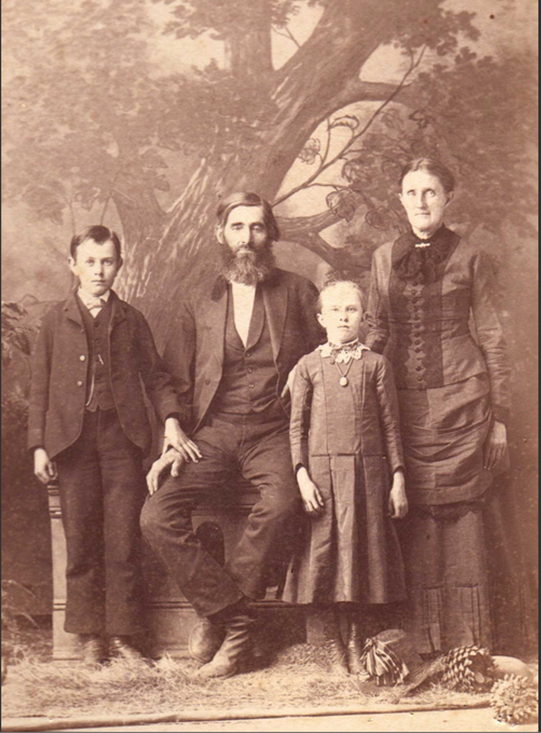Emalyn Smith Burney: An Endling

can’t go on. I’ll go on.
— Paul Kalanithi, When Breath Becomes Air
Emalyn first came to my attention in a sensational newspaper article from the Berlin News Records, April 26, 1913 (now Kitchener-Waterloo, Ontario, Canada):
He Died Again but Shock Killed his Grandmother
Butte, California, April 26, 1913
While mourners and relatives grouped about the open coffin of Mr. J. R. Burney’s three-year-old son Thursday, listening to the funeral service, the body moved. The child, clad in a shroud, sat up and gazed about the room. His eyes caught those of his grandmother, Mrs. L.P. Smith, 80 years of age,
The aged woman stared at the child as if hypnotized. Then she sank into a chair dead. As she fell, the child dropped back into the coffin, from which it was quickly snatched by the mother.
The physician said there was no hope for the boy and death came a few hours later. Yesterday there were two coffins in the Burney home. Double services were held and the child and its grandmother were buried side by side.
All this sounds quite sensational, but the reality, although deeply tragic, was somewhat more grounded in reality. What seemed to have happened was that the child had choked while eating a banana. Then, during the funeral services being held in the home, the grandmother, along with a pallbearer, were leaning over the boy and saw the child’s eye “relax” or twitch. At this point the grandmother fainted.
A doctor by the name of W.W. Gatliff was called in. He stated that what had been witnessed was a post-mortem relaxation of the eyelids, confirming that the child was still dead, and had been since the preceding Tuesday.
Other newspapers reported that what really happened is that the grandmother asked to hold the body of the toddler. His arm fell to the side and the grandmother thought he had returned to life.
But the grandmother did indeed die during or shortly after all the commotion.
The newspapers were a little less forthcoming with the names of those involved, and perhaps — as we shall see — with reason.
Why Emalyn? And What is an Endling?
Right now, before you read this sketch, Emalyn is less than a rumour, less than a footnote, less than a footnote to a footnote; she is utterly forgotten and unknown. Yet she once walked the streets of California. She was a woman with a story. She pushed forward in another time and place. Who knows what she might have done beyond what we will read here, what she may have become?
In the spring of 1996, the scientific journal Nature coined a new word: “endling”. The article was rather poetically entitled “The Last Word”. Created to describe the last known individual of a species (or subspecies), once an endling dies, that is the moment of extinction.
Although Emalyn is not technically an endling — our species is far from extinct — her branch on the family tree withered and died through a progression of profound tragedies. Almost everything about her has been obliterated, lost, destroyed, or discarded — as though she never existed.
Today I cannot imagine anyone other than myself and perhaps some distant reader, caring about Emalyn’s story. Yet she existed. She was a daughter, a sister, a wife, and a mother. She lived.
It is highly unlikely that there is anyone alive today who knew her. What can we call those who came before and those we can barely know? Even today, what do you call those who make up chance encounters — people who pass by on the street, in their cars, at the grocery store? Maybe those who quickly glance our way and move on? What about those people who circle our periphery, who somehow remain in our thoughts, shadows of memory yet no longer in our reach? I don’t believe we have a word for these people.
If however, this word existed, it could be applied to Emalyn. During her life, she interacted with hundreds or even thousands of people. Some encounters would have been merely a light brush, others profoundly meaningful. Yet almost all traces of her are lost; she is a relict in every sense of the word — both current and archaic. She is an endling.
What follows is a sliver of history, a recounting and gathering of what scant traces of her remain. Let us, now, try to honour her life.
Rebellion, Ruin, and Redemption
Who was Emalyn? It has taken a long time to answer that question, a siren calling through time. Writers, historians, and biographers strive to understand the heroes and the villains, but almost no one cares about those who don’t fit neatly into either category.
Author Stephen King, in his book On Writing: A Memoir of the Craft, defined one winning formula as the “Three R’s—Rebellion, Ruin, and Redemption”. We all know stories that follow that path (in fact, Oprah Winfrey’s book club recommendations almost always reflect this).
Did Emalyn rebel? Did she transgress the norms of her world? Perhaps. There are hints of it in her story, and also in the path taken by her mother. Did she come to ruin? Absolutely. Did she attain redemption? We may never know.
Did I Choose the Story, or Did the Story Choose Me?
All we really “know” about Emalyn is that tragedy followed her throughout her life like a hungry wolf. We don’t know with certainty her date or place of birth; the date and place of her marriage; nor where she finally ended her days.
There isn’t even any certainty about her name. She is variously documented as Emalyne, Emalyn, Emmalyn, Emmalyn, Emaline, Emmaline, Emma, or Emily; and her middle initial is sometimes shown as “R”, but what it stood for is long forgotten. Her signature did however appear in probate documents, and she signed “Emalyn R”. In this narrative we will call her Emalyn, accordingly.
The chronology is sparse.....
Intrigued? Curious? Emalyn lost her entire family. Her father died penniless. Her mother and son were buried on the same day. She had already lost a baby girl. Then, her remaining son was murdered. For the full essay please see my "sister" webpage at

Would you like to read other posts? If so, please click the Home Page link below:

You, Dear Reader, are much needed and appreciated.
Everything written requires a reader to make it whole. The writer begins, then you, dear reader, take in the idea and its image, and so become the continuation of its breath. Please subscribe so that my words can breathe. Consider this my hand, reaching out to yours.

